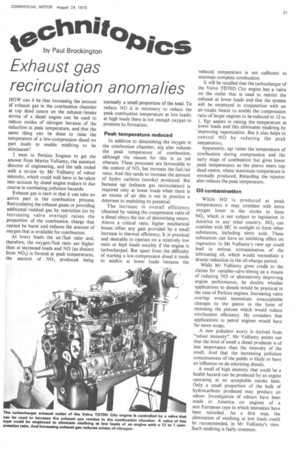te0 "1111 0
Page 33

If you've noticed an error in this article please click here to report it so we can fix it.
Exhaust gas recirculation anomalies
HOW can it be that increasing the amount Of exhaust gas in the combustion chamber at top dead centre on the exhaust /intake stroke of a diesel engine can be used to reduce oxides of nitrogen because of the reduction in peak temperature, and that the same thing can be done to raise the temperature of a low-compression diesel on part loads to enable misfiring to be elirhinated?
I went to Perkins Engines to get the answer from Martin Vulliamy, the assistant director of engineering, and the talk ended with a review by Mr Vulliamy of odour intensity, which could well have to be taken into account by diesel engine makers in due course in combating pollution hazards.
Exhaust gas is inert in that it can take no active part in the combustion process. Recirculating the exhaust gases or providing additional residual gas by restriction (or by increasing valve overlap) raises the proportion of the combustion charge that cannot be burnt and reduces the amount of oxygen that is available for combustion.
At lower loads the air/fuel ratio and, therefore, the oxygen/fuel ratio are higher than at increased loads and NO (as distinct from NO2) is formed at peak temperatures, the amount of NO2 produced being
normally a small proportion of the total. To reduce NO it is necessary to reduce the peak combustion temperature at low loads; at high loads there is not enough oxygen to promote its formation.
Peak temperature reduced In addition to diminishing the oxygen in the combustion chamber, erg also reduces the peak temperature of combustion, although the reason for this is as yet obscure. These processes are favourable to the control of NO, but increase the fuel/air ratio. And this tends to increase the amount of hydro carbons (smoke) produced. But because egr (exhaust gas recirculation) is required only at lower loads when there is an excess of air this is not in practice a deterrent to exploiting its potential.
The increase in overall efficiency obtained by raising the compression ratio of a diesel obeys the law of diminishing return. Above a critical ratio, higher mechanical losses offset any gain provided by a small increase in thermal efficiency. It is practical and desirable to operate on a relatively low ratio at high loads notably if the engine is turbocharged. But apart from the difficulty of starting a low-compression diesel it tends to misfire at lower loads because the
reduced temperature is not sufficient to maintain complete combustion.
It will be recalled that the turbocharger of the Volvo TD7OD City engine has a valve on the outlet that is used to restrict the exhaust at lower loads and that the system will be employed in conjunction with an air-intake heater to enable the compression ratio of larger engines to be-reduced to 12 to 1. Egr assists in raising the temperature at lower loads and this eliminates misfiring by improving vaporization. But it also helps to control NO by reducing the peak temperature.
Apparently, egr raises the temperature of combustion during compression and the early stage of combustion but gives lower peak temperatures as the piston nears top dead centre, where maximum temperature is normally produced. Retarding the injector also reduces the peak temperature.
Oil contamination While NO is produced at peak temperatures it may combine with extra oxygen lower in the stroke to form NO2 which is not subject to legislation in America or any other country. NO2 can combine with HC in sunlight to form other substances, including nitric acid. These substances can have an inhibiting effect on vegetation. In Mr Vulliamy's view egr could lead to serious contamination of the lubricating oil, which would necessitate a drastic reduction in the oil-change period.
While Mr Vulliamy gives credit to the claims for variable-valve-timing as a means of reducing NO or alternatively improving engine performance, he doubts whether applications to diesels would be practical in the case of Perkins engines. Increasing valve overlap would necessitate unacceptable changes to the piston in the form of recessing the pistons which would reduce combustion efficiency. He considers that applications to petrol engines would have far more scope.
A new pollution worry is derived from "odour intensity". Mr Vulliamy points out that the kind of smell a diesel produces is of less importance than the intensity of the smell. And that the increasing pollution consciousness of the public is likely to have an influence on de-odorizing diesels.
A smell of high intensity that could be a health hazard can be produced by an engine operating at an acceptable smoke limit. Only a small proportion of the bulk of hydrocarbons produced may produce an odour. Investigation of odours have been made in America on engines of a non-European type in which intensities have been recorded. As a first step, the elimination of misfiring at low loads could be recommended, in Mr Vulliamy's view. Such misfiring is fairly common.




















































































